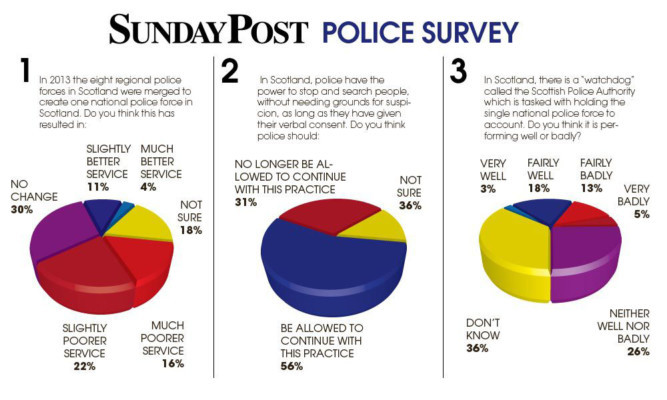
THE creation of a single police force has been branded a failure by fed-up Scots, who do however back the stop-and-search policy.
An exclusive new poll for The Sunday Post shows 38% of people feel the service on offer from the cops has got worse since the eight forces were merged in 2013.
Just 15% of those surveyed think things have improved since the creation of Police Scotland, piling the pressure on under-fire Chief Constable Sir Stephen House.
After days of intense scrutiny over the performance of Scotland’s police force, The Sunday Post can also reveal:
Police watchdogs have warned the force could run out of money to deliver expected reforms.
The main police control room has been forced to hire dozens of new staff after police chiefs laid off too many civilian call handlers, unions claim.
The majority of Scots support the controversial stop-and-search policy.
Liberal Democrat justice spokeswoman Alison McInnes MSP said: “This poll of public opinion is a damning indictment of the SNP’s rushed and ill-thought-out policing reforms.
“Since the introduction of a national police force, policing approach has changed wholesale.
“Police counters have closed their doors to the public, armed police have attended routine duties, the use of stop and search increased unabated and that is only the tip of the iceberg.”
The Survation poll of 1,000 Scots, conducted at the start of last week, asked respondents to rate the service provided by Police Scotland since the creation of a single force in 2013.
A total of 16% said the move had resulted in a much poorer service, while a further 22% said there was now a slightly poorer service.
By contrast, just 4% said the new setup had resulted in a much better service, while 11% said the service was slightly better.
Just under a third (30%) said there had been no change in the service, while the rest of those surveyed were not sure.
Labour’s justice spokesman Hugh Henry said: “The public still trusts our police officers, but confidence in senior management is being stretched to the limit with this shambles.
“When the most senior officers in the country keep changing their story on an important issue like stop and search and have to apologise for inaccurate statements, then the public must be left wondering what can be believed.”
Last week Scotland’s chief constable was grilled by MSPs over why the force had repeatedly “changed its evidence” over the number of children his officers are stopping and searching.
The row over the force releasing inaccurate data on the practice, which was meant to have stopped last summer, has snowballed into a focus on the wider performance of the single force.
Deputy Chief Constable Rose Fitzpatrick said: “Your survey shows the majority of those who expressed a view were either as content or more content with Police Scotland than previous eight legacy forces.
“Between January and December 2014, almost 16,000 people who contacted us to report crimes or incidents took part in our user satisfaction survey.
“More than 83% of respondents expressed satisfaction with how their incident was handled; almost 79% stated their confidence level in Police Scotland was high or very high.”
An SPA spokesman said: “We welcome feedback that more respondents feel that SPA is doing a good accountability job than those who do not.”
Meanwhile, it has emerged that the police control centre at Bilston Glen in Midlothian is looking to hire 34 new members of staff because of demand on its services.
George McIrvine, Unison branch secretary, said it was because too many experienced staff had been laid off during a rationalisation of the call centres.
He said: “It is symptomatic of a wider issue with the force. They have laid off all the people with experience then found themselves short and are now looking to hire inexperienced staff.”
Scots back stop-and-search policy
The police’s controversial stop-and- search policy has won the backing of the majority of Scots.
It was revealed Scots police had been carrying out nine times as many searches as officers in New York City.
A 400% rise in the searches since the creation of Police Scotland, including the hotly-contested frisking of children under the age of 12, has sparked a review of the way the practice is carried out. But the Post’s poll shows the public still back the principle of stop and search.
Asked if cops should be allowed to continue the practice of stopping and searching people, without needing grounds for suspicion and with verbal consent, 56% said it should continue.
A total of 31% said the police should no longer be allowed to continue with the practice, while the rest were not sure.
Calum Steele, General Secretary of the Scottish Police Federation, said: “This support has greater significance as it is set against possibly the worst weeks of headlines for stop and search.”

Enjoy the convenience of having The Sunday Post delivered as a digital ePaper straight to your smartphone, tablet or computer.
Subscribe for only £5.49 a month and enjoy all the benefits of the printed paper as a digital replica.
Subscribe